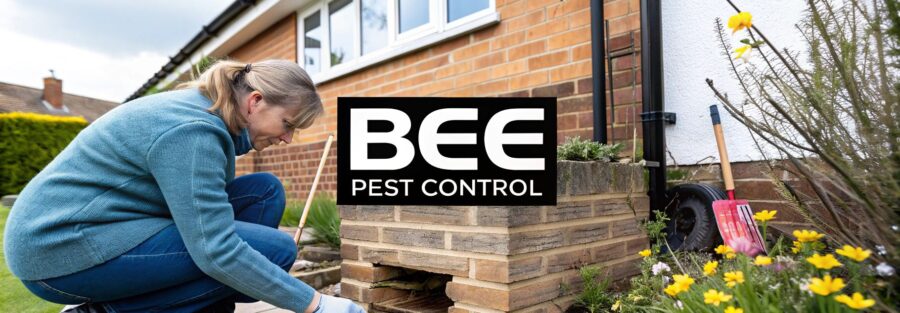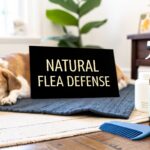Finding a bee swarm or nest on your property can be a bit of a shock. The key is to stay calm and observe from a safe distance. The first thing you need to figure out is what you're actually dealing with, because that will tell you whether you have a genuine pest problem or just some helpful pollinators passing through.
Your First Steps After Finding a Bee Nest
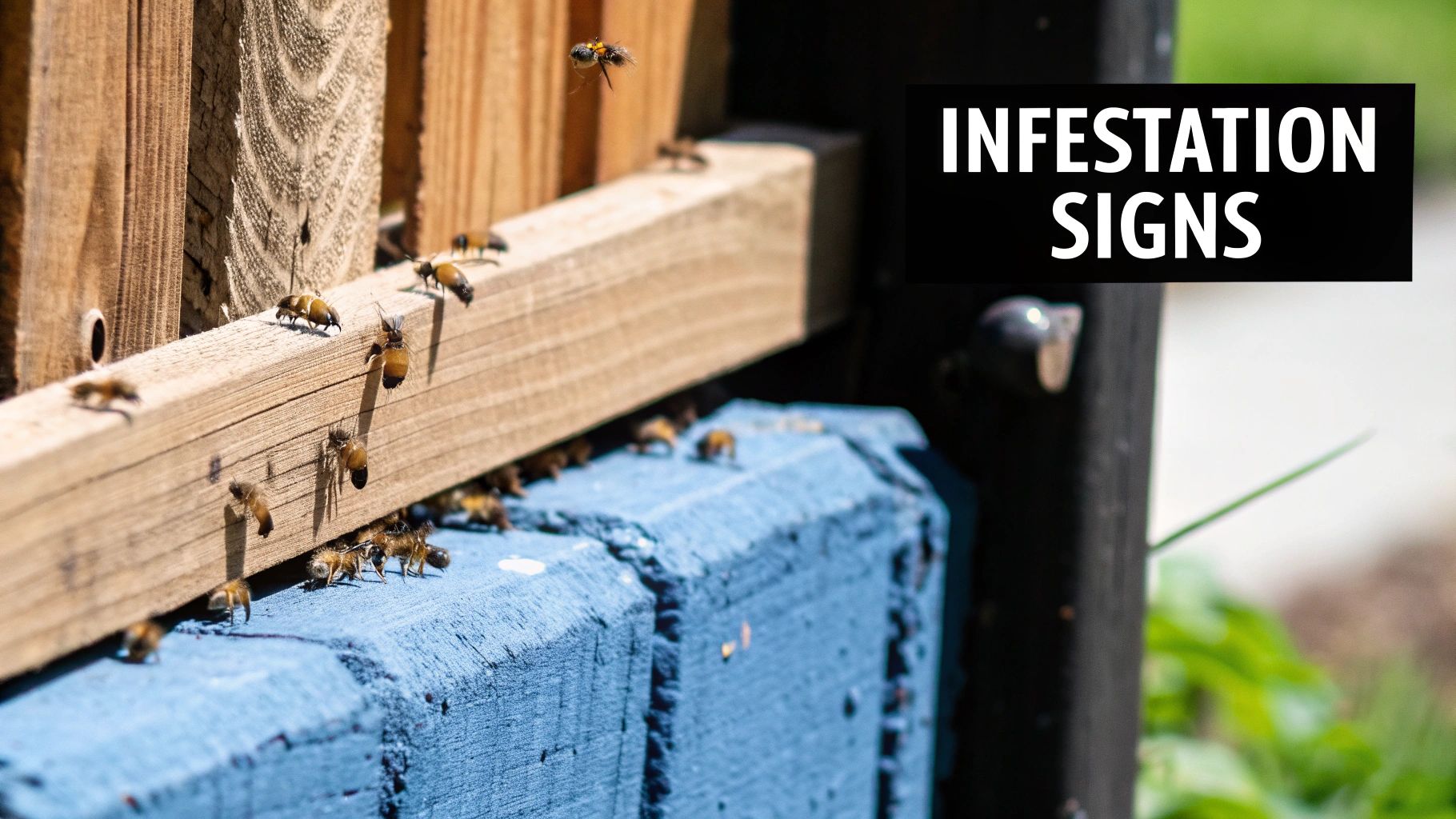
Seeing dozens, or even thousands, of buzzing insects is enough to make anyone feel uneasy. But panicking often leads to bad decisions. The most important thing to do is keep yourself, your family, and any pets well away from the nest or swarm. This isn't the time to try and sort it out yourself—that's a sure-fire way to provoke a defensive reaction and get stung.
Instead, use this time to gather some useful information. Your main goal is to work out if you’re looking at honeybees, bumblebees, or something more aggressive like wasps. Getting this initial ID right is crucial because it dictates the entire approach to safe removal.
Observe and Identify the Insects
From a safe spot—at least 15-20 metres away—have a good look at the insects' appearance and behaviour. Are they fuzzy and round like bumblebees, or are they more slender with those classic sharp yellow and black stripes like a wasp? Honeybees are usually a golden-brown colour and look a bit furry.
Also, pay attention to where the nest is. Different species have very different ideas of a good home.
- Honeybees often build large, waxy comb structures inside cavities, like hollow trees, wall voids, or chimneys.
- Bumblebees prefer smaller, messier-looking nests. You’ll frequently find them underground in old rodent burrows, in compost heaps, or under sheds.
- Wasps build those classic papery, grey nests that you might see hanging from eaves, trees, or tucked away in a shed.
To help you tell them apart, here's a quick guide.
Quick Guide to UK Bees and Wasps
Spotting the difference between a bee and a wasp can be tricky, but it's the first step in deciding what to do next. This table breaks down the key features to help you identify what's buzzing around your garden.
| Insect | Appearance | Nest Location | Temperament |
|---|---|---|---|
| Honeybee | Golden-brown, slightly furry body. | Large, waxy nests in cavities like chimneys or wall voids. | Generally docile, but will defend the hive if threatened. |
| Bumblebee | Larger, round, and very furry (often black and yellow, or with white/orange tails). | Small, unstructured nests in compost heaps, under decking, or in bird boxes. | Very calm, rarely stings unless its nest is directly disturbed. |
| Wasp | Slender body, smooth (not furry), with distinct yellow and black stripes. | Grey, papery nests hanging from eaves, in attics, sheds, or underground. | Aggressive, especially in late summer. Can sting multiple times. |
Understanding these differences is vital. For a more detailed breakdown, you can read our in-depth comparison of wasps and bees and what you need to know before calling the pros.
Why Professional Assessment is Non-Negotiable
Once you have a rough idea of what you're up against, the next step is always to call a professional. Trying to block an entrance hole or spray a nest yourself can backfire badly. For example, if you seal honeybees inside a wall cavity, you won't get rid of them. They’ll just chew their way out somewhere else—and that "somewhere else" could be right inside your living room.
A professional assessment isn't just about safety; it's about doing things correctly and legally. In the UK, bees are vital pollinators, and many species are protected. A qualified expert can identify if the bees are a protected species and whether relocation is a viable and lawful option.
A trained technician will properly evaluate the situation, considering several key factors:
- The species of bee and its typical behaviour.
- The location and accessibility of the nest.
- The potential risk to people and the building's structure.
This expert evaluation is the foundation for a safe and effective plan. It ensures the removal process aligns with UK conservation efforts, prioritising the relocation of our valuable pollinators whenever possible. True bee pest control is rarely about extermination; it’s about managing the situation with ecological responsibility and finding a long-term solution.
Why Bee Health Is a National Concern
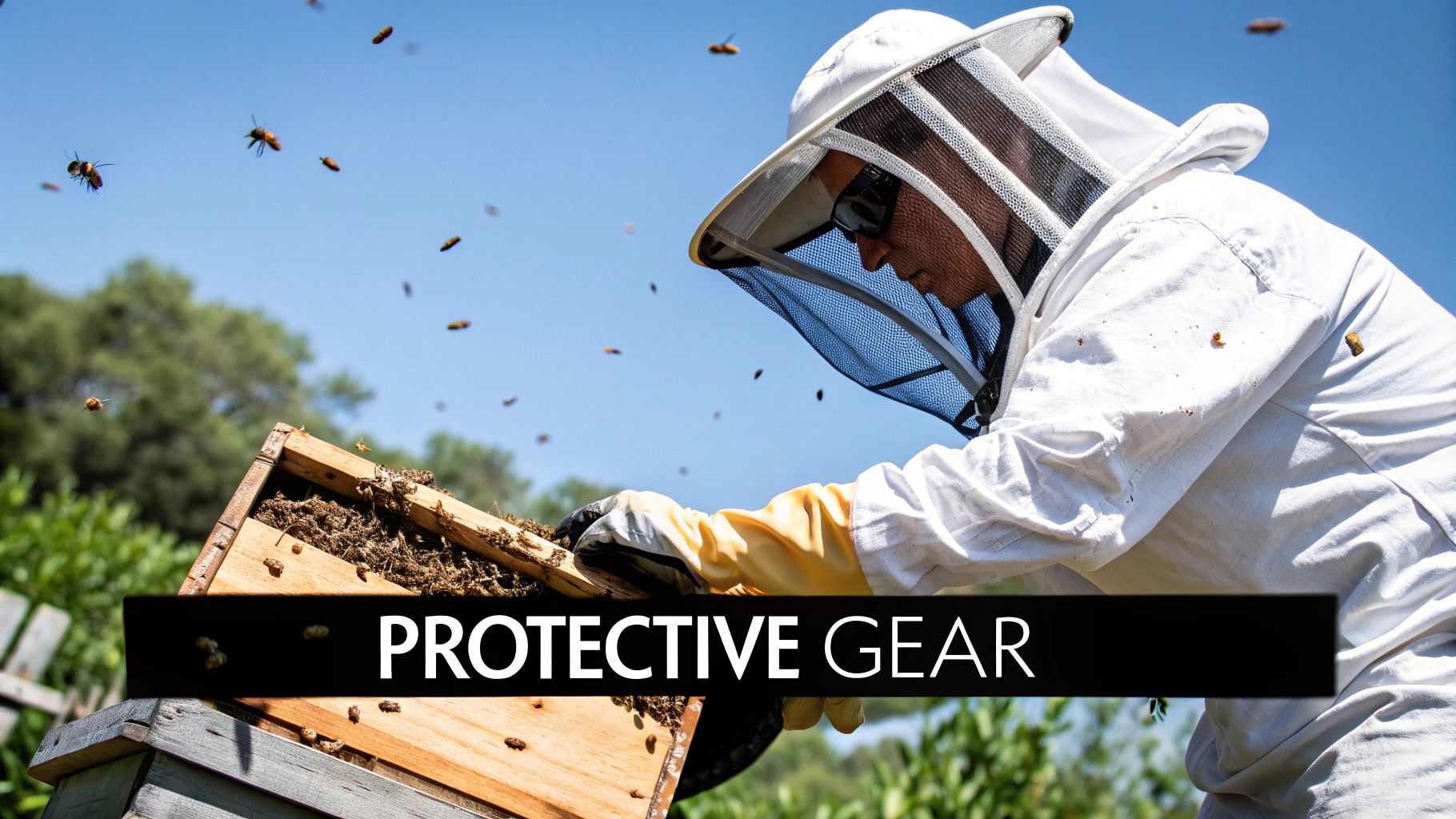
To make responsible choices about bee control, it helps to understand why these insects are so incredibly important on a national scale. A nest in your garden wall isn't just an isolated problem; it’s a tiny piece of a much larger ecological puzzle that affects our food supply and environment across the UK.
When we talk about bee health, we’re not just talking about managed honeybees. We're also talking about the hundreds of species of wild bees, like bumblebees and solitary bees. Together, they are the powerhouse behind pollinating many of our agricultural crops, from apples and strawberries to oilseed rape.
The value they provide is immense, estimated to be worth hundreds of millions of pounds to the UK economy every year. Without their diligent work, our farms would struggle, and food prices would inevitably rise. This is why a threat to bees is a threat to us all.
The Pressures Facing UK Bee Populations
Unfortunately, bee populations in Great Britain are facing a formidable array of challenges. These pressures create a difficult environment for them to thrive, making every single colony that much more precious.
A primary concern is habitat loss. As our towns and cities expand and modern farming changes the landscape, the wildflower meadows and natural nesting sites bees rely on are disappearing. On top of that, environmental changes and unpredictable weather patterns put immense strain on them. A long, cold spring can delay foraging, while a summer drought can wither the very flowers they need for nectar and pollen.
"A decline in bee populations is more than just an environmental issue; it is an economic and food security issue. The health of our pollinators is a direct indicator of the health of our ecosystems."
This combination of factors weakens bee colonies, making them far more vulnerable to pests and diseases.
A Closer Look at Colony Health Trends
The story of bee health in the UK is one of challenges and resilience, all clearly documented by national monitoring programmes. Looking at the data gives you a real sense of the scale of the problem. For instance, data from the National Bee Unit shows a worrying trend between 2001 and 2008, when the proportion of inspected honeybee colonies found dead in England and Wales rose from about 4% to nearly 13%.
This period really highlighted the devastating impact of pests, particularly the parasitic Varroa mite, which became a persistent threat after its arrival in 1992. If you're interested in the details, you can explore the data from the Senedd research to see the full scope. That period was a massive wake-up call, showing just how quickly colony health could spiral downwards.
Responding with Responsible Action
Fortunately, the story doesn't end there. Following the peak losses around 2008, things started to improve, particularly in Wales. This shift suggests that better pest management techniques and increased awareness among beekeepers and the public began to make a genuine difference.
This is where your decisions come into play. Understanding that bees are under constant threat helps reframe the issue of a nest on your property. Instead of seeing it merely as a nuisance, we can see it as an opportunity to act responsibly.
Opting for professional and humane bee pest control, such as live relocation, contributes directly to the larger conservation effort. Every healthy colony that is saved rather than destroyed is a small but meaningful victory for our national pollinator population. By choosing preservation, you support the beekeepers and ecologists working to bolster bee numbers and ensure they can continue their vital work for generations to come.
The Hidden Threats Inside the Hive
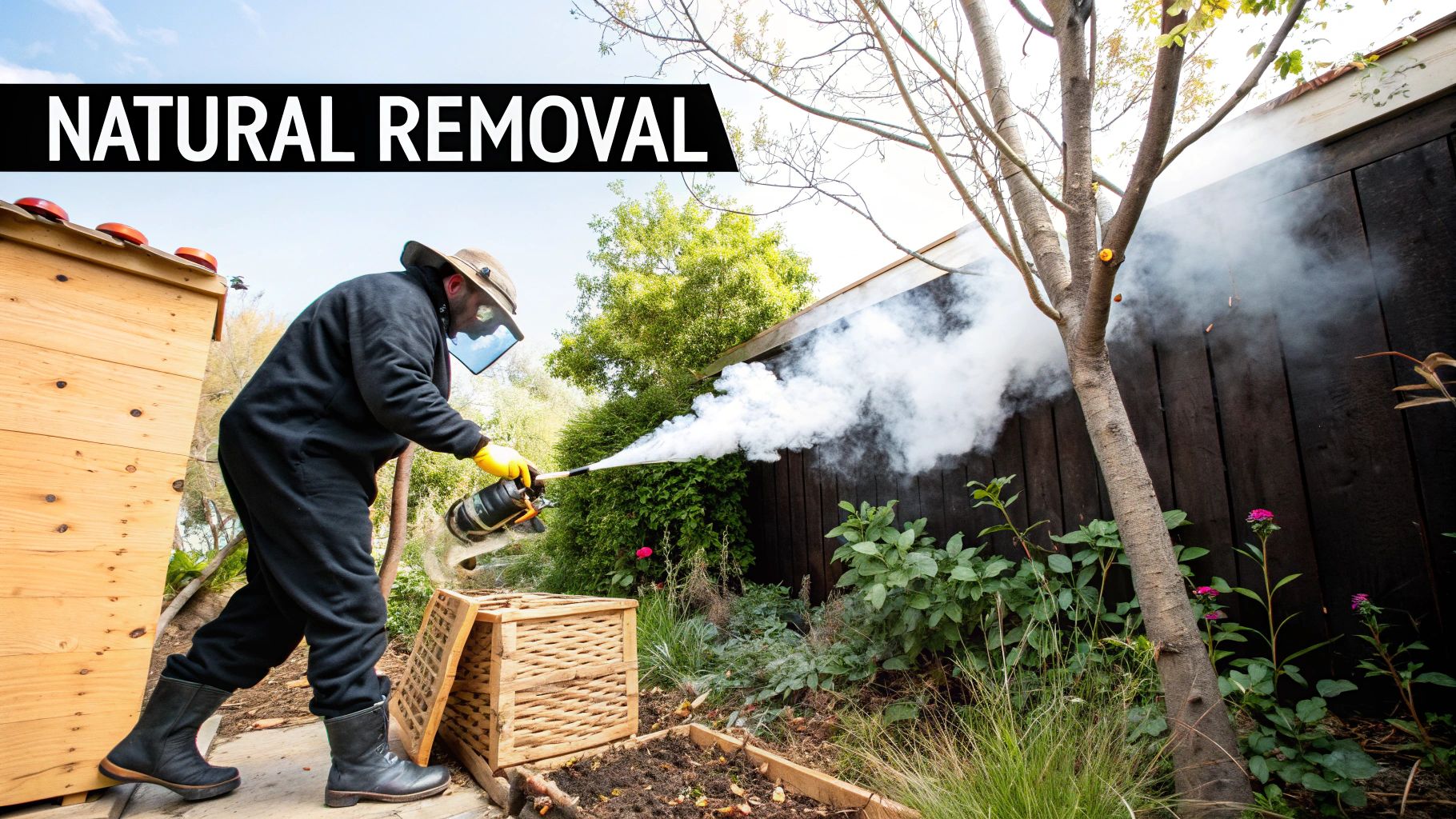
When we talk about responsible bee pest control, it's not just about removing a nest. It's about understanding the complex battles bees are already fighting every single day. A hive might look like a marvel of organisation from the outside, but inside, it can be a battleground where invisible enemies bring entire colonies to their knees.
Knowing about these internal threats gives you a real appreciation for the resilience of bees—and for the delicate balance beekeepers work so hard to maintain.
At the top of the list of challenges is a pest so destructive it has completely reshaped beekeeping in the UK. This tiny parasite is the single biggest threat to honeybee health, turning what should be a safe haven into a ticking time bomb.
The Notorious Varroa Destructor Mite
If there’s one villain in the story of UK honeybee decline, it’s the Varroa destructor mite. This external parasite, no bigger than a pinhead, latches onto adult bees and their young (the brood), feeding on their vital fatty tissues.
To put it in perspective, it’s like a human having a creature the size of a dinner plate attached to their body, constantly draining their strength. That’s the reality for an infested honeybee.
But the physical damage is just the start. As Varroa mites feed, they act as tiny syringes, injecting a cocktail of deadly viruses directly into the bee's system. Viruses that a healthy bee could normally fight off suddenly become lethal, causing everything from deformed wings and paralysis to a drastically shortened lifespan.
A colony with a high mite count quickly becomes a weakened, diseased, and dysfunctional society.
You simply can't overstate the impact of the Varroa mite. It's the main reason that wild honeybee colonies are now incredibly rare in the UK. Without a beekeeper managing mite levels, most colonies will collapse within two to three years.
This constant fight against Varroa is a core, relentless part of modern beekeeping. It requires vigilant monitoring and treatment just to keep mite numbers below the catastrophic threshold.
The Domino Effect of Pests and Environment
A Varroa infestation is bad enough on its own, but its effects are often amplified by other stressors—especially the notoriously unpredictable British weather. A colony already weakened by mites is far less prepared to survive a long, cold winter or a wet summer with poor foraging.
The connection between pest pressure and environmental factors is stark. The Varroa destructor mite has been the most damaging pest to UK honeybee colonies since it arrived in 1992. It was a key driver behind the huge colony losses seen throughout the 2000s.
At its peak in 2007/08, overwinter colony losses hit an astonishing 30%. This devastating figure was largely blamed on the parasite weakening hives, with bad weather finishing them off. As beekeepers got better at managing mites, losses stabilised to between 16% and 21%.
But then, poor weather in 2012 and 2013 caused losses to spike again to 33.8%, proving just how fragile this balance is. You can see the full government review of these findings to understand the complex interplay between pests and bee health.
This data tells a crucial story: a pest problem is never just a pest problem. It’s a full-blown health crisis that leaves bees vulnerable to every other challenge they face.
When a homeowner finds a honeybee nest, that colony could already be struggling with a heavy mite load. This is precisely why professional bee pest control prioritises relocation. Moving the colony to an apiary gives a beekeeper the chance to properly assess its health, treat for Varroa, and give the bees a fighting chance. It's an act of preservation that respects the hidden struggles unfolding inside every hive.
How Professionals Safely Relocate Bees
When you're dealing with a bee infestation, especially one that's tucked away inside the walls or roof of your property, you need more than just a can of spray. This is a job that calls for specialised skills and equipment. Professional bee pest control isn't about extermination; it's a careful, strategic operation focused on preserving the colony while protecting your home.
The methods we use depend entirely on the situation—where the nest is, how long it's been there, and the behaviour of the bees themselves. It’s a process that should never be attempted as a DIY project due to the significant risks involved. Two of the most common and humane approaches are the "trap-out" and the "cut-out." Each serves a different purpose, but both share the same goal: moving the bees on safely.
This is a simplified look at how a professional thinks, weighing the different factors to choose the most responsible removal method.
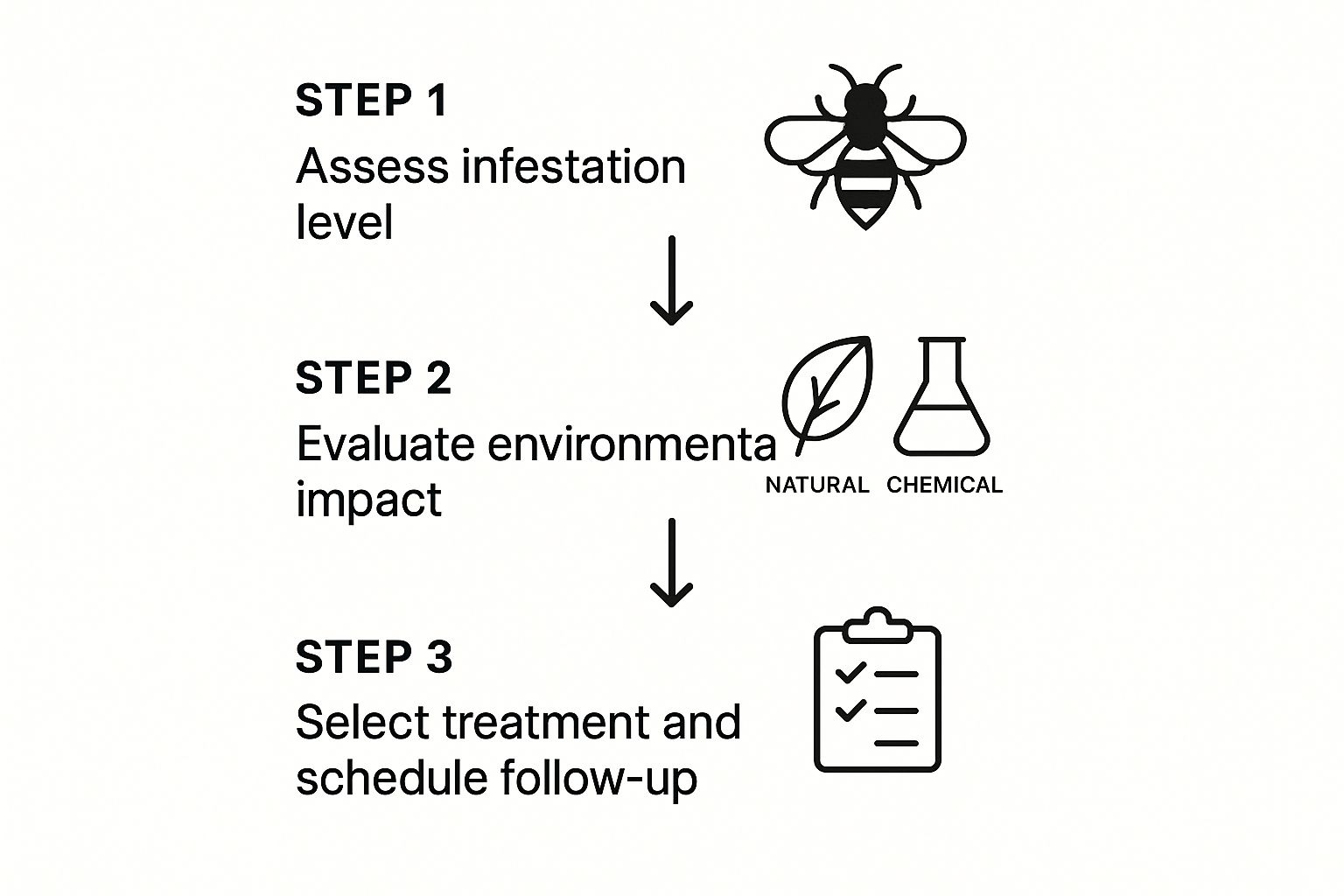
As you can see, the first step is always to assess the infestation and its location. This assessment dictates whether a gentle, eco-friendly approach is possible or if, in rare cases, other measures are needed before planning any follow-up care.
The Gentle Art of the Trap-Out
Let’s say a colony has made its home deep inside a brick wall where you can't easily get to it. A trap-out is a clever, non-invasive method designed for exactly this kind of scenario. It works by using the bees’ own instincts against them.
First, a professional will find and seal every tiny crack and crevice the bees might be using, leaving only their main entrance open. Over this single exit, they’ll install a special one-way cone. The bees can fly out to forage for nectar, but they can't figure out how to get back in through the narrow end of the cone.
Next, we place a small, temporary hive (called a "nucleus box") nearby. This box contains a new queen bee and some honeycomb. As the foraging bees return and find themselves locked out of their old home, they're naturally drawn to the scent of the new queen and hive. Over several weeks, the entire workforce gradually moves into the new box.
A trap-out is all about patience. It gently redirects the colony's behaviour without causing any structural damage. Once the original colony inside the wall has dwindled and the old queen stops laying eggs, the process is complete, and the entrance can be permanently sealed.
This technique is perfect for structures where cutting into the building isn't practical, like listed buildings or solid masonry walls.
The Surgical Precision of a Cut-Out
A cut-out, on the other hand, is a much more direct and often faster way to remove a colony. It involves physically opening up the structure—whether it's a wall, floor, or ceiling—to get direct access to the honeycomb and the bees. It's a delicate operation that requires not just bee expertise but also some solid building and repair skills.
We'll often use tools like thermal imaging cameras to pinpoint the exact location and size of the nest. This helps minimise the cut and the disruption. Once the nest is exposed, the real work begins.
- Calming the Colony: The first step is to use a bee smoker. The smoke masks the bees' alarm signals, which helps to keep them calm and less defensive during the removal.
- Removing the Comb: We carefully cut out each piece of honeycomb. Any sections containing brood (the bee larvae and pupae) are carefully preserved and secured into new frames, which are then placed into a proper hive box.
- Gathering the Bees: Most of the adult bees, including the queen, are gently collected using a specially designed, low-suction "bee vac." This bit of kit is designed to suck the bees into a holding container without harming them.
After all the bees and comb are gone, the cavity has to be cleaned meticulously to remove every last trace of wax and honey. This is a critical step. If any scent is left behind, it can attract a new swarm down the line. Finally, the structure is professionally repaired, leaving no trace that we were ever there.
While it's more invasive, a cut-out is often the most thorough solution for well-established colonies. In these complex situations, understanding the full range of pest control services available is key to ensuring a permanent solution.
Comparing Professional Bee Removal Methods
Here's a quick look at the humane bee removal techniques we use, their best applications, and why professional handling is so important for a successful outcome.
| Technique | Best For | Complexity | Key Consideration |
|---|---|---|---|
| Trap-Out | Nests in inaccessible locations like hollow walls, chimneys, or historic structures where cutting is not an option. | Low-Medium. Requires patience over several weeks. | Non-invasive and preserves the building's integrity. The old comb remains sealed in the structure. |
| Cut-Out | Established colonies inside accessible voids (walls, ceilings, floors). | High. Requires building skills and specialised equipment. | The most complete removal method. All comb, honey, and bees are physically removed and relocated. |
Both methods are designed with one primary goal: to relocate the bees safely while ensuring your property is cleared of the infestation for good. Choosing the right one depends entirely on the unique circumstances of your bee problem.
Creating a Bee-Friendly and Pest-Free Property
After you’ve had a bee colony safely relocated, the last thing you want is for a new swarm to move straight back in next season. The key to long-term success isn’t just about removal; it’s all about prevention. This means making your property a place where bees are welcome to forage, but strongly discouraged from nesting where you don't want them.
Real bee pest control is about finding a balance. You can absolutely support these vital pollinators without inviting them to become unwanted houseguests. It all starts with making your home’s structure a lot less appealing to scout bees on the hunt for a new home.
Fortifying Your Home Against New Nests
Think of your home's exterior as a fortress. Scout bees are incredibly good at finding tiny, unsecured gaps that lead to perfect nesting cavities. Your job is to find and seal these weak points before they do.
Get started by doing a thorough walk-around of your property's exterior. Pay very close attention to the spots where different building materials meet, like around window and door frames, or where utility pipes and wires enter the house.
Even a tiny crack in the mortar or a small gap under the eaves can look like a five-star hotel to a honeybee swarm. Use a quality, weather-resistant sealant or caulk to fill these gaps properly. For any larger openings, expanding foam or even wire mesh can be effective deterrents.
Essential Property Maintenance Tips
- Secure Vents and Chimneys: Cover all vents, including those for the attic and soffits, with fine-mesh insect screens. Make sure your chimney has a proper cap that lets smoke out but keeps animals and insects from getting in.
- Inspect Wood Structures: Regularly check sheds, decks, and wooden play equipment for signs of carpenter bees. They drill perfectly round holes into untreated wood. A fresh coat of paint or varnish makes the wood far less attractive to them.
- Manage Outdoor Clutter: Old plant pots, forgotten equipment, and piles of wood can all provide sheltered spots for bumblebees or solitary bees to nest. Keeping your garden tidy simply reduces the available real estate for them.
A crucial thing to remember is that bees are drawn to scent. If a colony was removed from a wall cavity, the lingering smell of beeswax and honey acts as a powerful magnet for future swarms. It's absolutely vital to make sure the cavity is thoroughly cleaned and all remnants of the old nest are gone.
Cultivating a Bee-Friendly Garden the Right Way
Making your home less attractive to nesters doesn't mean your garden has to be hostile to pollinators. In fact, it’s the opposite. By creating a rich, welcoming foraging area away from your house, you can support local bee populations while keeping them at a comfortable distance.
The goal is to provide food, not shelter. Plant a diverse range of native, pollen-rich flowers that bloom at different times throughout the year. This creates a reliable food source for all sorts of different bee species. Great choices for UK gardens include lavender, foxgloves, poppies, and clover.
This kind of proactive support is more important than ever. The ecological pressures on bees are immense, with long-term UK monitoring showing a 25% decline in species occupancy across 139 wild bee species between 1980 and 2013. Some common species, like the Red-tailed Bumblebee, have faced devastating drops. These declines are a direct result of pressures from pests, parasites, and habitat loss. You can explore the detailed findings on UK wild bee status to learn more about these trends and the conservation work helping them recover.
Your Long-Term Prevention Checklist
Creating a lasting solution is a combination of structural proofing and smart gardening. It's an ongoing process, not just a one-off job.
| Prevention Area | Actionable Task | Why It Works |
|---|---|---|
| Structural Proofing | Seal all cracks and gaps in walls, foundations, and around pipes. | Eliminates easy entry points for scout bees searching for a new cavity to nest in. |
| Entry Point Screening | Install fine-gauge mesh screens over vents and chimneys. | Physically blocks access to desirable, sheltered nesting locations like attics and wall voids. |
| Garden Management | Plant diverse, native flowers away from the house. | Provides a valuable food source, encouraging bees to forage in your garden without nesting in your home. |
| Regular Inspections | Annually inspect your property for new signs of activity. | Early detection allows you to address potential issues before a colony becomes fully established. |
By taking these steps, you transform your property from a potential problem zone into a positive part of the local ecosystem. You actively reduce the chances of a future infestation while helping out our crucial pollinators. If you ever have concerns about a returning issue, understanding your options for professional wasp and bee treatment can provide that extra peace of mind.
Your Bee Removal Questions, Answered
Finding a bee colony on your property can feel daunting, and it's completely normal to have a lot of questions. From the cost and how long it takes, to whether you're even allowed to move them, UK homeowners tend to have the same worries. We've put together some straight answers to help you understand the process.
How Much Does Professional Bee Removal Cost?
This is usually the first thing people ask, and honestly, it all comes down to the job's complexity. A simple swarm hanging from a branch is a world away from a colony that's been living inside a chimney for five years.
Several things will affect the final price:
- Where is the nest? Is it easy to get to, like in a low bush, or is it three storeys up and needing scaffolding?
- What's the removal method? A gentle, non-destructive "trap-out" requires different time and equipment than a structural "cut-out."
- Is there any repair work? If we have to open up a wall or roof to get to the colony, the cost will naturally include making good on that repair work afterwards.
Any reputable specialist will give you a detailed, transparent quote after they've seen the situation for themselves. Be very wary of any company offering a low, flat-rate price over the phone without a proper inspection.
It helps to think of professional bee removal as an investment. Paying for a proper job that includes live relocation and cleaning out the cavity properly prevents much bigger costs later on—like structural rot from honey or having to deal with another colony moving in next year.
How Long Does It Take to Remove a Bee Colony?
Just like the cost, the timeline really varies. A straightforward swarm collection can be done and dusted in just a couple of hours. Established colonies, however, are a different ball game entirely.
A surgical "cut-out" from a wall we can easily access might be finished in a day. On the other hand, a "trap-out" is a much slower, more patient game. This can take anywhere from three to eight weeks as we gently encourage all the bees to move from the structure into their new hive box. How long it takes depends on how big the colony is and the time of year.
Are Bees Legally Protected in the UK?
This is a really common and important question. While there's no single law that makes it illegal to disturb all bees, the situation isn't black and white. All wild birds and their active nests are protected by the Wildlife and Countryside Act 1981, but bees don't have that same specific protection.
However, certain actions can get you into trouble. For example, using pesticides incorrectly or in a way that harms other wildlife could lead to prosecution. More importantly, there's a strong ethical and ecological duty here. With our pollinators under so much pressure, professional pest controllers and beekeepers will always put live relocation first. The goal is always conservation, not destruction.
What Happens to the Bees After They Are Removed?
When we can carry out a humane removal, the bees get a new lease on life. The entire colony—queen, brood, comb, and all—is carefully collected and transported to a local apiary.
Once there, a beekeeper gives them a proper home in a standard hive. The colony gets a full health check, is treated for any pests like the Varroa mite, and is managed to help it grow strong. These relocated bees get back to their vital job of pollination, boosting the local ecosystem. It’s the best result for everyone.
Will the Bees Come Back to the Same Spot?
This is a huge risk if the job isn't finished correctly. Bees leave behind incredibly powerful smells. Old beeswax, honey, and pheromones act like a massive 'vacancy' sign, attracting new swarms that are looking for a pre-vetted home.
This is why professional bee pest control is about more than just taking the bees away.
- Total Clean-Out: The cavity has to be scraped completely clean of every last bit of comb and honey.
- Scent Neutralisation: We then treat the area to mask any lingering odours that could attract other bees.
- Permanent Sealing: Finally, the entry point must be sealed up for good with strong, durable materials.
If you skip these vital last steps, you're essentially leaving the door wide open for a new colony to move in, sometimes in the very same season.
When you've got a bee problem, you need a solution that's safe for your property, effective, and responsible. At Pest Predators Limited, our expert team uses proven methods to not only remove bee colonies but also to stop them from coming back, protecting both your home and our vital pollinators. Contact us today to schedule your professional assessment.

